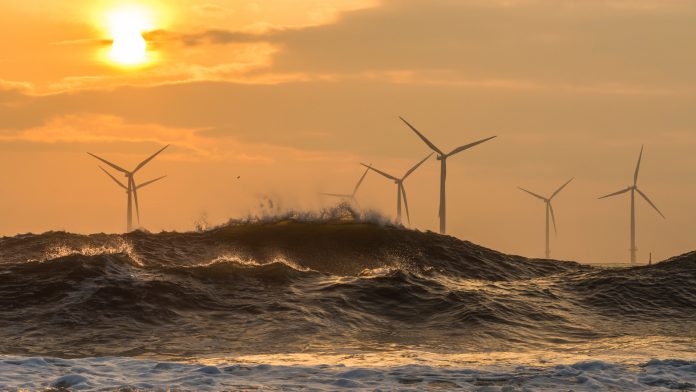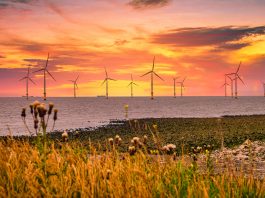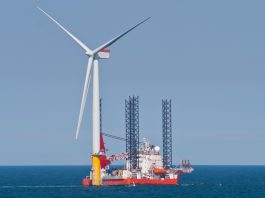A research team from the University of Colorado Boulder has created hurricane-resilient wind turbines, effectively revolutionising the field of wind technology.
Wind technology is expanding significantly; today’s offshore wind turbines can reach up to 490 feet above the ground, with each of their spinning blades generating up to eight megawatts (MW) per day. This is enough to power approximately 4,000 homes in the US.
However, large turbines also have disadvantages. For example, some offshore wind turbines, located off the east coast of the US, are exposed to the increasingly powerful Atlantic hurricanes, which threaten not only the structures themselves but also the future of wind energy. Thus, to help create hurricane-resilient wind turbines, a team of CU Boulder researchers are taking nature into account and turning the turbine around.
“We are very much bio-inspired by palm trees, which can survive these hurricane conditions,” explained Lucy Pao, Palmer Endowed Chair in the Department of Electrical, Computers, and Energy Engineering.
Traditional offshore wind turbines
Conventional offshore wind turbines face the incoming wind, and to avoid being blown into the tower, their blades must be sufficiently stiff. It requires a lot of material to build the relatively thick and massive blades, which drives up their cost. Turbine blades on downwind rotors, however, face away from the wind, so there is less risk of them hitting the tower when the winds pick up. This means they can be lighter and more flexible, which requires less material and therefore less money to make. These downwind blades can also then bend instead of break in the face of strong winds—much like palm trees.
The segmented ultralight morphing rotor
Over the past six years, Pao’s has team worked collaboratively with the University of Virginia, the University of Texas at Dallas, the Colorado School of Mines, and the National Renewable Energy Laboratory. Scientists were able to develop the segmented ultralight morphing rotor (SUMR) turbine, which is a two-bladed, downwind rotor to test the performance of this lightweight concept in action.
On 10 June, at the American Control Conference, CU scientists presented results collected from a new study that consisted of four years of real-world data. This included the results from testing their 53.38-kilowatt demonstrator (SUMR-D) at the National Renewable Energy Laboratory’s (NREL) Flatirons Campus, just south of Boulder, Colorado. They revealed that their turbine performed consistently and efficiently during periods of peak wind gusts, which they considered to be a satisfactory result.
“The blades are manufactured to be lightweight and very flexible, so they can align with the wind loads. That way, we can reduce the cost of the blades and bring down the cost of energy,” said Mandar Phadnis, lead author of the study, and a graduate student in electrical, computer, and energy engineering.
Scientists have emphasised that this innovative work presents the perfect opportunity for the hurricane-resilient wind turbine to mitigate the negative effects of climate change. This is because climate change not only demands that we quickly transition to more cost-effective and reliable renewable energy, but also that rising global temperatures are also likely to cause hurricanes to intensify.
Hurricane activity this year in the Atlantic is predicted to be above average, with NOAA’s Climate Prediction Centre estimating up to six major hurricanes with winds reaching approximate speeds of 111mph from 1 June to 30 November.
Addressing inconsistent wind speeds with the ‘hidden brain’
One of the most difficult elements of wind energy generation is dealing with too little or too much wind. When wind speeds are too low, a turbine cannot produce a useful amount of energy. In contrast, when the wind is too fast, it can push the limits of a turbine’s capacity, causing it to shut down to avoid a system overload.
The inconsistency of wind speed has been an issue regarding wind energy since its establishment; the lost time spent shutting down the system leads to less energy generated and less efficient production.
A critical element of Pao’s innovative contributions is improvements to the controller, which is the part of the turbine that determines the intensity of power production.
“We like to think of the controller as essentially the brain of the system,” observed Pao, senior author of the study from the Renewable and Sustainable Energy Institute (RASEI).
Thus, the ‘hidden brain’ aims to generate efficient wind energy at low cost and with low wear and tear. “The feedback controller does this by utilising measurements of how the system is performing, and then adjusting to better improve the performance,” added Pao.
The yaw controller assures that the turbine is facing the correct direction, the blade pitch controller determines the direction of the blades (dependent on the wind speeds), and the generator torque controller decides exactly how much power to pull off the turbine and onto the grid. While it controls the physical components of the turbine, these controllers are essentially a software algorithm that tells the motors what to do.
Assuring that the hurricane-resilient wind turbine operates during peak wind events
Pao’s group is not only turning the turbine around to reduce damage from strong winds but also working behind the scenes on its software to maximise the system’s ability to keep running during peak wind events.
“Our work attempts to predict the likelihood or the probability of peak wind gusts occurring, and then tries to mitigate the speed peaks by acting before they happen,” noted Phadnis.
The research team noted that the NREL’s Flatirons Campus’ was the perfect place to test peak wind event capacity in action, as it is strategically placed to receive the strong winds, which shoot out across Highway 93 and onto the mesa, after being funnelled through Eldorado Canyon directly to the west.
There, the researchers discovered that, even through extensive experimental testing, peak generator speeds were below the threshold for their operational controller to keep the turbine running.
In a separate collaboration, Pao and her team have been working with the University of Oldenburg in Germany to assess the utility of sensors that scan ahead of the turbine to measure the wind coming in and of advanced controllers that command the turbine to respond promptly.
Measuring the possibilities of wind technology
“While downwind or two-bladed turbines like the SUMR-D may not come to dominate the wind energy industry, by performing these multi-year, real-world tests, the researchers are able to better understand what might be possible,” said Pao.
The control algorithms that have been developed could also be equally relevant to traditional three-bladed, upwind turbines, which still dominate both land and offshore markets.
“The advantage of the downwind configuration, however, really comes about when you get to extreme-scale turbines, and those are primarily for offshore,” added Pao.
Pao’s team is already making strides in addressing these great heights; with their collaborators, they have designed and modelled (but not yet experimentally tested) large-scale, offshore 25 MW and 50 MW SUMR (downwind) turbines.
Ultimately, scientists believe a combination of improved controllers, lighter, resilient materials, and strategic turbine configurations could allow for giant offshore turbines to outpace the competition. They are not only more cost-effective and energy-efficient, allowing for one big turbine instead of many smaller ones – which would reduce installation and maintenance costs – they are also able to capture faster wind speeds higher off the ground and can withstand the more severe weather scientists anticipate.
“Wind turbine blades are typically designed to last at least 20 years, and we want our novel concept blades to achieve similarly long lifetimes,” concluded Pao.









